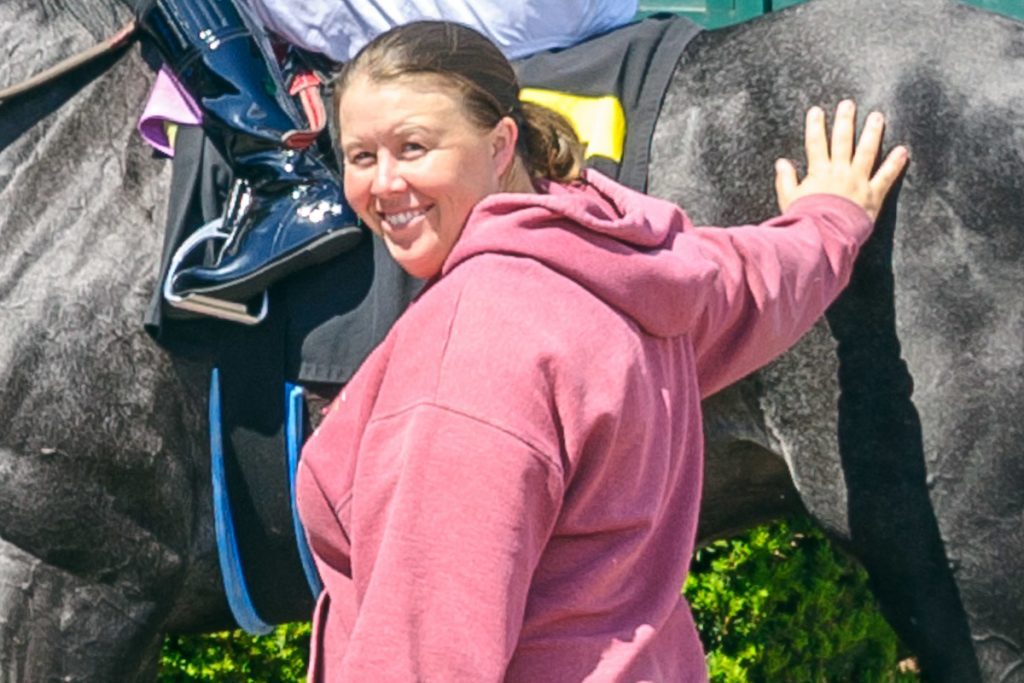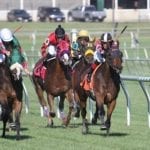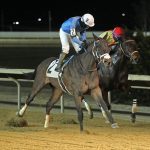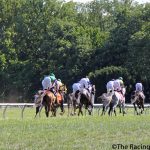DELAWARE: KELSEY DANNER ON THE UPSWING

Kelsey Danner’s is a new face in the Mid-Atlantic. But she – or more precisely, her family – is a longtime fixture in the Thoroughbred industry.
“I think I’m… am I like the fourth generation?” she asked one recent afternoon, then ticking off family members in the game. “My mother, my grandmother, my great grandfather…”
Danner has 18 head at Delaware Park, the first time she’s had horses here, with the remainder of her 50-horse operation at Palm Meadows in south Florida.
And she has enjoyed a productive Midlantic summer; her horses have won six of 24 starts at Delaware, and she’s added two more wins, plus a stakes placing, at Colonial Downs.
“The last couple years, I had a small string in New York,” she explained. “And with Covid, I went to Florida last year, and that worked out well, so I kept them down there. But with Churchill tearing up the turf course this summer, I decided to go ahead and go to the East Coast because there’s some more options.”
It’s a decision that’s seemed to work out well. Beyond the wins, her horses are happy, she said.
“I like that it’s an old-school track,” Danner noted of her Delaware Park environs. “I like the barn I’m in. The horses like it; they sleep better, eat better. It’s a more relaxing environment.”
Danner’s father, Mark Danner, trained horses from 1991 to 2017, while her mother Kelly Danner worked on the frontside at Churchill Downs. That, coupled with other family members in the industry, made it clear from an early age the path the now-35-year-old would follow.
- Grayson-Jockey Club Foundation announces 2025 funding
 More than $2.6 million in Grayson-Jockey Club Foundation funding will support 16 new and 10 continuing projects.
More than $2.6 million in Grayson-Jockey Club Foundation funding will support 16 new and 10 continuing projects.
“I took out my assistant’s license when, I think I was 18,” she said. “I don’t think I had much choice. I think my parents would have preferred me to finish college and go do something else. But, you know, all I wanted to do was ride horses.”
Well, that desire to ride horses, plus another factor.
“My dad got sick with cancer, and I ended up taking a string of horses for him at Oaklawn when he did chemo,” she recalled. “I was kind of on my foot out of college anyway, so it was a good experience.”
Her father went into remission, and in subsequent years, Danner worked for trainers like D. Wayne Lukas, Ian Wilkes, and Carl Nafzger. In 2011 she found her way to Wayne Catalano’s barn, where she stayed five years.
Those years coincided with some of the most productive of Catalano’s career. In 2011 the Catalano-trained Stephanie’s Kitten won the Breeders’ Cup Juvenile Fillies Turf, one of the trainer’s three career Breeders’ Cup wins. And Catalano, who has won more than 2,900 races, logged purse earnings of more than $4 million in each three consecutive years, from 2012 to 2014.
“He had a nice couple years there,” Danner said. “That’s when he had Stephanie’s Kitten, all the Kitten’s Joys. We had some nice ones for Gary and Mary West.”
In 2016, though, Danner stepped away from the racetrack, working for WinStar Farm for a time while living with her grandfather in Lexington, KY. She took out her trainer’s license in 2017, saddling her first horse that August.
She didn’t saddle a winner that year, in fact, didn’t even have a horse finish in the money until a runner-up effort that December. But she hit the ground running in 2018, winning with Majestic Bold, her first starter of the year. Each year since, her charges have won more races and earned more money than the year before, a streak she’s on track to extend this year.
So far in 2021, Danner’s runners have won 25 races and earned just over $740,000. And it may be that the best is yet to come.
Danner has unveiled a pair of first-out juvenile winners at Delaware this meet. Gorman, an American Freedom filly, bested maiden special weight foes June 21. And Longshadow, a colt by Tapiture, opened some eyes August 5 when he graduated by over 10 lengths. He’ll make his next start in the $500,000 Kentucky Downs Juvenile Mile September 6.
- Op-ed: Time to modernize the condition book
 Modernizing the condition book with 21st-century technology could be a cause that unites horsemen and management — and is long overdue.
Modernizing the condition book with 21st-century technology could be a cause that unites horsemen and management — and is long overdue.
Those two are among a group of horses helping Danner to upgrade her stock gradually.
“When I first started, I kind of got like the fifth string,” she said. “My clients have supported me, and we’ve bought more from the sales this year and last year. So I got two-year-olds last year, and the three-year-olds I have I’ve had since they were babies for the most part and developed them a little bit.”
Longshadow, a $7,000 purchase at the Keeneland September yearling sale last year, was the only baby she purchased at that event. This year, she says she’s expecting to come back with five to ten yearlings.
Still, even for an up-and-comer, these are challenging times in the Thoroughbred industry. One challenge that she pointed to is as old as the game itself. “As a trainer, having those discussions can be a little bit heartbreaking with owners when you deliver bad news,” she said, whether that’s the bad news that a horse needs a new career or something worse.
Another challenge she has faced is a relatively new one: the labor shortage on the East Coast, which has stretched trainers thin while forcing them to adapt on the fly.
But resolving those challenges is just part of a trainer’s job.
“I’m lucky to have some really good owners that are horsepeople,” Danner said. “They understand.”
LATEST NEWS














